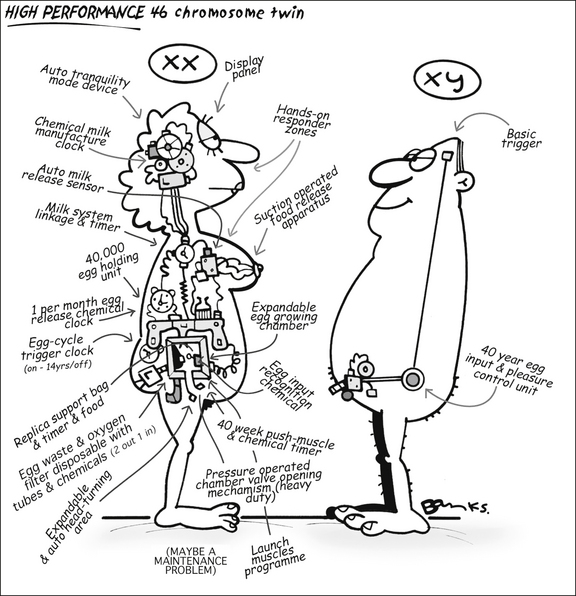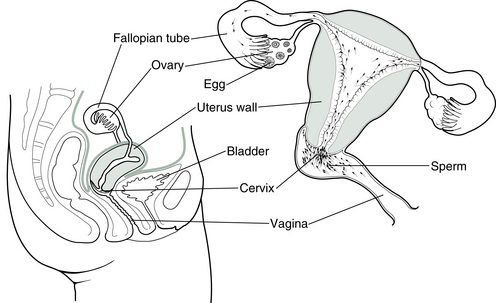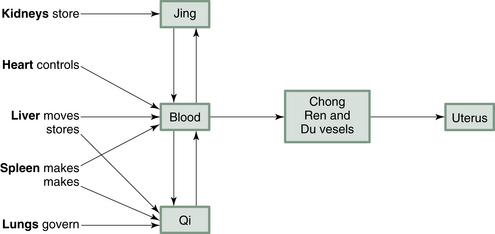2
The menstrual cycle
Becoming a Specialist in Female Infertility
There is an oft quoted saying in Chinese medical texts, ‘the treatment of women is ten times more complicated than that of men’ (Fig. 2.1). By the time we have examined all the different parts of the menstrual cycle you may feel this is an understatement!

Figure 2.1 Women are 10 times more complicated than men. (Reproduced with permission of Bruce Petty.)
To be a specialist in any field, we have to know our chosen material intimately. In this chapter, I set out what we need to know about the pathways, the fluids, the cells, the tissues, the chemical messages and the changes that happen in every menstrual cycle. We will examine in detail all the complex events that happen in a woman’s body when the glands in the brain communicate with the reproductive glands and induce a myriad of different effects in different tissues – an incredible orchestration of events, which require correct timing and constant feedback. The result is a woman’s body full of fertile potential (Fig. 2.2).
In this chapter, I consider the roles of the Yin and the Yang, the Qi and the Blood, the Chong and the Ren vessels, the Jing and the Shen, and more. And I also consider estrogen and progesterone, the pituitary and hypothalamus glands, the follicle in the ovary containing the egg, the fallopian tubes and the endometrium lining the uterus.
The Chinese and Western Medicine Approach
Although it is not appropriate to make exact equivalences between traditional Chinese medicine concepts and modern scientific medical descriptions (representing two profoundly different paradigms) we can make parallels – identical processes viewed from different perspectives. These will be summarized once we are familiar with all the terms (see Table 2.2).
Table 2.2
Summary of parallels between traditional Chinese medicine (TCM) and Western medicine terms
| Western physiology | TCM |
| The gametes | Jing |
| The influence of the sex hormones | Kidney Yin and Yang |
| The influence of the hypothalamus and the pituitary | Heart |
| Ovaries, tubes, endometrium and cervix | Uterus |
The following sections provide a brief explanation of terms used to describe organ systems, channels and substances relevant in TCM gynecology. For further explanation of such TCM concepts, the reader is referred to TCM texts on internal medicine.1
The Organs
The Kidney, the Heart and the Uterus
The pathways or channels, called the Bao Mai (Uterus vessel) and Bao Luo (Uterus channel), provide the means of communication between the Heart, Uterus and Kidneys (Fig. 2.3).
It is interesting to note that old Chinese medicine texts describe the Heart as the master controller (the Emperor) of the other organs. In the same way, Western medicine often refers to the hypothalamus and the pituitary as the master controllers of other glands in the body.
The other organs
While the kidneys and the heart control the processes necessary for female fertility, they are not the only organs or systems necessary for the effective functioning of the menstrual cycle. Figure 2.4 shows the relationship between all the body’s Yin organs and the Uterus.
It is said in TCM that the Kidneys ‘dominate reproduction’ and are the store of reproductive essence, or Jing, which is discussed below. The Kidney Jing plays a key role in female physiology at all its stages – puberty, pregnancy and menopause. Aspects of Kidney also influence libido and sexual function. The Heart houses the mind or spirit – ‘Shen’ in TCM terms – and, as such, exerts a subtle but powerful influence over many aspects of the menstrual cycle. The Spleen and Liver also contribute in a less direct way to aspects of reproduction and fertility. The Spleen produces the Blood and the Liver stores and moves it; therefore both can have an effect on the nourishment of the Uterus. The Spleen also controls circulation of Blood in its vessels. The Liver is responsible for smooth movement of Qi and therefore plays a critical role during events surrounding ovulation and menstruation, both of which involve movement and change. The Lungs are less directly involved, but also influence Qi. More detailed explanations of Yin organ function can be found in TCM texts on internal medicine.1
The Substances
Jing is not only an important first determinant of our basic constitution, but it is also directly related to our ability to produce children of our own. If a girl is born with very deficient Jing, then it is likely that the ovaries or uterus may not develop properly and there will be complete sterility. Puberty, if it comes at all, will be very late, as will development of secondary sexual signs. In women, Jing deficiency (Table 2.1) manifests as primary amenorrhea, resistant ovary syndrome or sporadic and intermittent cycles (oligomenorrhea) or premature menopause (see Ch. 5). Or there may be less severe levels of Jing deficiency, which may manifest as delayed puberty, or very intermittent ovulation or the production of poor quality eggs which do not easily fertilize and make strong embryos. In men, we may see very low sperm counts or even no sperm (see Ch. 7). All degrees of Kidney Jing deficiency spell problems with fertility.
Table 2.1
| Severe Jing deficiency | Moderate Jing deficiency | Mild Jing deficiency |
| No puberty, late puberty Primary amenorrhea Small uterus and ovaries Underdeveloped secondary sexual characteristics Weak constitution Sterility No response to fertility drugs | Delayed puberty Oligomenorrhea Premature menopause Resistant ovary syndrome Poor or no response to fertility drugs Possibly poor constitution or small stature Relative infertility | Normal puberty and menstrual cycle Poor or no response to fertility drugs Relative infertility |
According to TCM theory, strong Jing is the basis of healthy Shen or spirit. Human worth can be evaluated in many ways, not just by physical strength and ability to reproduce. Such human attributes as altruism, artistic endeavor and scientific genius make great (non-biological) contributions to human society. Many of these attributes stem from aspects of our spirit or the Shen. Inheritance of good Jing is necessary, therefore, not only for a healthy physical constitution and the ability to reproduce but also for the development of other human attributes which contribute to humanity in ways other than continuing its genetic lines.
What causes decline in Kidney Jing?
Kidney Jing can be consumed more rapidly by some types of lifestyle or circumstance than others (see Ch. 12). Epigenetic effects of assisted reproduction technology may also be of concern as far as Jing is concerned (see Chs 9–11).
How is Kidney Jing deficiency treated?
In some men with no or very few sperm, testicle biopsies can be taken and immature sperm cells cultured. These can then be used for in vitro fertilization by injecting them directly into the egg (see Ch. 9).
Babies born to parents with congenital gonadal dysfunction or with unexplained infertility with the aid of ART seem to be, in the current broad view, as healthy as other babies. However, research reveals that babies born as a result of these procedures are more at risk of major birth defects2 and will tend to have lower birth weights.3 This may reflect the original cause of the infertility as much as the effects of the procedures (for more discussion of these effects, please see Ch. 10).
Yin
How is Kidney Yin deficiency treated?
In the clinic, large doses of herbs are prescribed to a Yin-deficient woman to increase the Kidney and Liver Yin so that the ovaries are nourished sufficiently to produce healthy eggs. Such an approach is emphasized in the weeks of the menstrual cycle leading up to ovulation; this treatment also encourages the retention of blood in the uterine lining along with its secretory function. Equally important in the treatment of the Yin is appropriate lifestyle changes. There is usually so little space in our lives these days for stillness and calling a halt to relentless busyness. Even when we say we are resting, we are watching television or movies, and our mind and body, while they may be more relaxed, have not stopped to the point where deep and nourishing rest can replenish reserves. A regular routine and enough sleep are two key first steps in reducing stress and relieving the mind. The capacity to still the mind is an important aim for the Yin-deficient person who is restless and nervous.
Blood
What causes Blood deficiency?
Inadequate protein in the diet is a frequent cause of Blood deficiency, and it often falls to the TCM doctor to persuade a pale and wan vegetarian patient to try and consume more protein. If a woman experiences very heavy periods over a significant length of time, then she will easily become Blood deficient. Past illness and a constitutional tendency to anemia will also be contributors to Blood deficiency.
Stay updated, free articles. Join our Telegram channel

Full access? Get Clinical Tree





